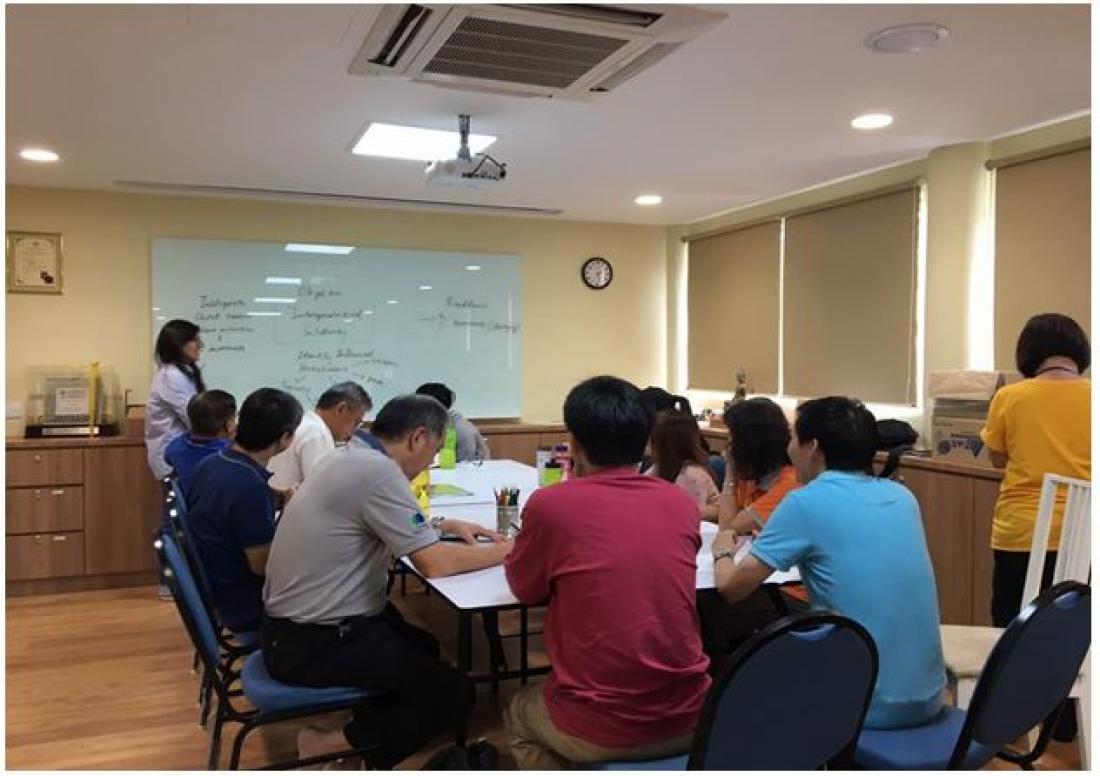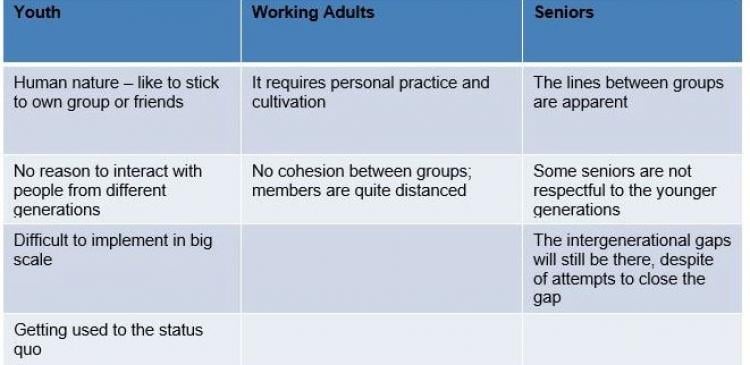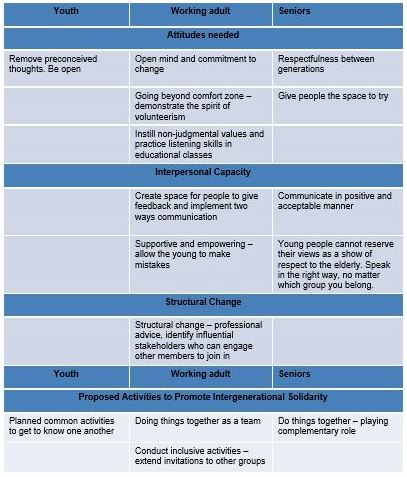Review session on how intergenerational solidarity could be implemented in their community
According to the United Nations’ sustainable development goals, inclusion is emphasized to reduce inequality and promote prosperity. Intergenerational solidarity is recognized by both the United Nations and the World Health Organization as one of the inducers for promoting inclusive society and aged-friendly environment. Meanwhile, the Malaysian National Policy for Older Persons and Plan of Action for Older Persons were approved by the government in 2011 also stressed the importance of inclusion. In particular, the objective of the policy is to empower the individuals, families and community to provide friendly services to the older persons effectively and efficiently, and to ensure enabling and supportive environment for the well-being of older persons. The six strategies to attain its objective are:
(i) Promotion and Advocacy
(ii) Life-long Learning
(iii) Safety and Security
(iv) Governance and Shared Responsibility
(v) Intergenerational Solidarity
(vi) Research and Development
Though much have been stressed on the significance of intergenerational solidarity at higher levels, documentation on the dynamics of intergenerational solidarity and the perceptions of community members are direly scarce. Particularly, greying is burgeoning in many NGOs in Malaysia, and successor plan is a worrisome topic.
The article is about preliminary attempt to build intergenerational solidarity from the University of Malaya’s collaboration with a religious community in Malaysian urban area. The lessons learned not only provide insights for future implementation of intergenerational solidarity in other communities, but also contribute to craft policy relevant to the community. The religious community was established in 1980s. Since instilling religious education to the younger generations is significant, the community expanded its religious education to different generational groups - children, youth and adults. In addition, the community extended care and support to its members. Senior fellowship was initiated too to promote active ageing in the community.
The community-university partnership started in late 2016 when they were establishing their senior fellowship. This study was conducted under the Wellness Research Cluster of the UM Grand Challenge, with SUB-GC number GC002C-14 HTM and SUB-GC title Social Participation and the Effects of Social Intervention in Older Persons with Osteoarthritis (SPESI-OA). The shorter version for this research is called PISA study. The UM PISA researchers adopted participatory action research paradigm and aligned with their direction to work with the community, rather than to work for the community. Lacking of intergenerational solidarity and successor plan surfaced as crucial issues in the community during discussion and deliberation. Later, the segregation among the generations were also acknowledged. This has been a pertinent issue, but has not been seriously dealt with. It is also a complex issue to deal with in a short period of time. Often, intangible, complex and yet important issue in the communities would be swept under the carpet.
Communication skills and values to induce interpersonal relationship were identified as crucial to gel the intergenerational groups. As a result, enhancing interpersonal interaction was prioritized. Volunteer training was proposed to enhance intergenerational solidarity through acquiring empathetic listening skill. Different generational groups participated in the volunteer training (4 from youth group, 3 working adults and 6 seniors aged above 60). The training involved empathetic listening skill’s learning and practice. Small group sharing of personal experience increased the cohesion among generations. They envisaged to form seed group which will pass on knowledge to enhance the interpersonal skills in their organization. After the training, a review meeting was conducted to understand how the knowledge could be translated into organizational practice. The table shows challenges and suggestions acknowledged by the different generational groups.
The generational groups agreed that the following factors should be avoided in building intergenerational solidarity:
• Labeling
• One directional communication
• Engaging only labor force contribution, and not involvement of persons (eg. the youth was
commonly asked to get involve in moving things, but not in planning and decision making)
• Remaining status quo
• Stereotyping
• Imposing assumptions or order onto people
• Demand respect
Experience and Lessons Learned
Overall, most participants in the volunteer training felt that the training created a sharing platform for different generations to interact and share. They admitted that the involvement of younger generation is crucial as new ideas, technology and innovations could be introduced. However, they demonstrated a mixture of feelings (optimism, pessimism, and puzzle) in terms of how to translate into organizational practice.
The researchers’ initial attempt helped to understand the complexities of building intergenerational solidarity in an organization. For instance, how individuals or different generations perceived and experienced the challenges in building solidarity are diverse. Orchestrating the members to move towards one direction required time, understanding and exchange of knowledge so that awareness, buy-in and acting towards the common goal can be attained. Community-university collaboration cannot work on micro scale capacity building in the organization alone without concerted influence from the macro levels.
Two structural dimensions were implicated for reflection and learning –the existing siloed mindset of the organization, and the readiness of research institution to support implementation of intergenerational solidarity in community. To address the siloed mentality, the researchers found that negotiations, discussions and education needed to be in place for leaders to be convinced about the idea of intergenerational solidarity. In addition, the external macro influence through media, private and governmental initiatives to promote and fund intergenerational projects can increase the awareness on inclusiveness. Secondly, academic institutional support (handling of human resource, time and funding) in building intergenerational solidarity can be different from experimental research. Time is important factors to support the growth of the community. The duration and time underpinning the man power’s contractual involvement and the flexibility of funding allocation. Making changes in the community include prioritizing the community’s concerns, identifying their resources and strengths, consolidating issue that needs to be resolved among stakeholders, proposing plans for resolving the issue, instilling vision for change, buying-in the influential stakeholders, acting towards change, assessing the impacts of change and evaluating on the collaboration. The development of community project needs to prioritize the community’s concern.
Besides structural dimension, the interpersonal dimensions are also worth to be reflected and learnt. The youth was not demonstrating much initiation to interact with the older generation, though they were open to listen and learn during the volunteer training. Lacking of initiation to interact with the older generation can be caused by the nature of being youth (stick to their peers) and the interaction between the younger and older generation, which is often turning casual conversations into lecturing. As such, these create the segregation further as the older generation would just leave the youth aside. Cultural expectation for young people to respect their elderly further hinders the youth’s assertiveness in interaction.
To overcome the aforementioned challenge, intergenerational solidarity can be gradually introduced to the youth in order to overcome the nature of youth’s tendency to stick to their peers. Youth should have their circle of peers for interaction while expand their circle of friends to different generations. They can play the complementary role in planning, decision making and implementing. On the other side, the older persons need to be mindful of their communication pattern, while the youth is empowered to be assertive in expressing their views and experience in a respectful manner.
Building intergenerational solidarity in the religious community has opened the researcher’s’ eyes in experiencing possibilities and difficulties to gather interested parties to be involved in partaking this journey. The community members have demonstrated openness to intergenerational involvement, but the commitment might be hindered by the existing culture and the involvement of key players of the organization. Micro and macro structural stimulations and capacity in interpersonal relationships among the generations can synergize intergenerational solidarity. More ground projects and research are needed to understand the dynamics in different types of communities, so that implementation of intergenerational solidarity supports not just older persons, but builds a reciprocal support across generations.
For more information, kindly contact
1. Dr. Teoh Gaik Kin
Dept. of Nursing Science, Faculty of Medicine, University of Malaya.
[email protected]
2. Prof. Dr. Tan Maw Pin
Dept. of Medicine, Faculty of Medicine, University of Malaya.
[email protected]
3. Dr. Chong Mei Chan
Dept. of Nursing Science, Faculty of Medicine, University of Malaya.
[email protected]





